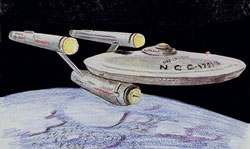 |
| Spaceship Earth? Photo: NCC-1701-A by tram_painter on Flickr (cc-by-nc-nd) |
Prof Mike Hulme has a thoughtful post on the UEA’s 3S blog today on how metaphors affect the way we think (about science and other things), reflecting on a recent talk by Johan Rockström packed with imagery about planetary boundaries, tipping points and other engaging ideas.
Prof Rockström will be coming to Sussex University on 16 May to speak about planetary boundaries and Sustainable Development Goals – part of our Spring mini-series of lectures and debates.
Prof Hulme writes:
“Metaphors abandon the pretence that we can describe things as ‘they truly are’ from a God’s-eye point of view. Rather, they concede that we can only see the world around us and inside us from a human-eye view. Consequently, metaphors are never innocent.
…This is as true of our understanding of the planet as it is of our own bodies. Is the Earth a spaceship to be steered (by us?) on a journey, an Earth mother with whom we must bond or, as in the case of planetary boundaries, a dashboard with dials to be managed so that the indicators are kept out of the red zone?”
You can read the full post on the 3S blog.
(Related: my colleague Julia Day wrote a summary of the debate a few weeks ago between Melissa Leach, Robert Pielke Jr. and Victor Galaz on what the framing devices of planetary boundaries and the ‘Anthropocene’ might mean for democratic decision-making.
I’ve also blogged before about research from the USA suggesting how medical metaphors might affect decision-making in crime policy.)
This article was originally posted on the The Crossing.